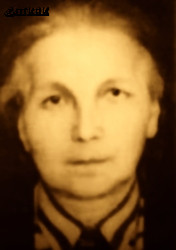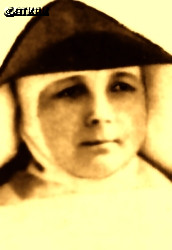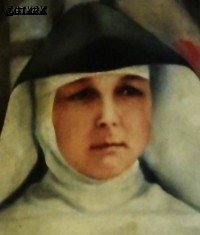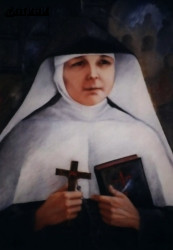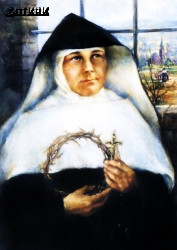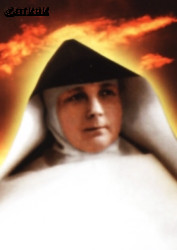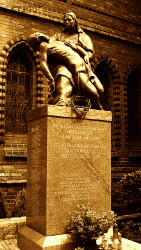Roman Catholic
St Sigismund parish
05-507 Słomczyn
85 Wiślana Str.
Konstancin deanery
Warsaw archdiocese, Poland
full list:
displayClick to display full list

searchClick to search full list by categories
wyświetlKliknij by wyświetlić pełną listę po polsku

szukajKliknij by przeszukać listę wg kategorii po polsku

Martyrology of the clergy — Poland
XX century (1914 – 1989)
personal data
religious status
blessed
surname
KRATOCHWIL
forename(s)
Mary Anne (pl. Maria Anna)
religious forename(s)
Mary Antonina (pl. Maria Antonina)
beatification date
13.06.1999more on
www.swzygmunt.knc.pl
[access: 2013.05.19]

the RC Pope John Paul IImore on
en.wikipedia.org
[access: 2014.09.21]
function
nun
creed
Latin (Roman Catholic) Church RCmore on
en.wikipedia.org
[access: 2014.09.21]
congregation
Congregation of the School Sisters of Notre Dame SSNDmore on
en.wikipedia.org
[access: 2013.05.19]
(i.e. School Sisters of Notre Dame)
diocese / province
Lviv archdiocesemore on
en.wikipedia.org
[access: 2013.05.19]
date and place
of death
02.10.1942

Stanislavivtoday: Ivano‐Frankivsk, Stanislaviv/Ivano‐Frankivsk rai., Stanislaviv/Ivano‐Frankivsk obl., Ukraine
more on
en.wikipedia.org
[access: 2020.11.20]
details of death
After German and Russian invasion of Poland in 09.1939 and start of the World War II, after start of Russian occupation, forced to abandon teaching responsibilities due to Russian nationalization of schools and ban on religious education.
In 02.1940 forced moved with 9 nuns into a single room in her Congregation's house — the rest was taken over by Jewish Communist students from Lviv, collaborating with Russians who turned the building into a holiday house.
In c. 03.1940 evicted from this single room — moved into Greek Catholic nuns local congregation's house in Mikuliczyn.
All bar one managed to avoid Russian deportation of Poles into Russia.
After German attack on 22.06.1941 of their erstwhile ally, Russians, returned to their house taking over half of it for the rest was appropriated by Ukrainians, collaborating with Germans, and turned into an Ukrainian school.
Arrested together with 6 co‐nuns — including Sr Hermione Łapa and Sr Sabine Dziurdzia — on 09.07.1942 by the Germans.
Transported to Stanislaviv prison.
There held with Fr Edward Tabaczkowski, among others.
Locked in a cell with 29 women — with 7 beds and no mattresses.
Repeatedly interrogated and maltreated.
After standing up for Jewish co‐prisoner beaten up with a wood stick.
Not able to lie down.
Together with his co‐nuns released on 26.09.1942.
Taken to infectious diseases hospital — had signs of typhoid — perished few days later.
cause of death
extermination
perpetrators
Germans
sites and events
StanislavivClick to display the description, Help to the JewsClick to display the description, Deportations to SiberiaClick to display the description, Ribbentrop‐MolotovClick to display the description, Pius XI's encyclicalsClick to display the description
date and place
of birth
21.08.1881

Vítkovicetoday: district in Ostrava, Ostrava city dist., Moravian‐Silesian reg., Czechia
more on
en.wikipedia.org
[access: 2024.03.19]
parents
KRATOCHWIL John
🞲 ?, ? — 🕆 ?, ?

KOLARZYK Joanna
🞲 ?, ? — 🕆 ?, ?
baptism
03.09.1881

Vítkovicetoday: district in Ostrava, Ostrava city dist., Moravian‐Silesian reg., Czechia
more on
en.wikipedia.org
[access: 2024.03.19]
St Paul RC church
religious vows
27.09.1910 (temporary)
positions held
12.1939 – 1942
superior — Mykulychyntoday: Yaremche urban hrom., Yaremche rai., Stanislaviv/Ivano‐Frankivsk obl., Ukraine
more on
uk.wikipedia.org
[access: 2022.09.12] ⋄ Congregation's house, School Sisters of Notre Dame SSND
1932 – 1939
nun — Lvivtoday: Lviv urban hrom., Lviv rai., Lviv obl., Ukraine
more on
en.wikipedia.org
[access: 2022.01.16] ⋄ Provincial House, School Sisters of Notre Dame SSND — director and teacher of the school run by the Congregation, superior in the formation of candidates for the Congregation
1925 – 1932
superior — Tlumachtoday: Tlumach urban hrom., Stanislaviv/Ivano‐Frankivsk rai., Stanislaviv/Ivano‐Frankivsk obl., Ukraine
more on
en.wikipedia.org
[access: 2020.12.03] ⋄ Congregation's house, School Sisters of Notre Dame SSND — head of the boarding school and training school at the Private Teachers' Seminary and the Female Gymnasium Maria Piłsudska née Billewicze
1917 – 1925
nun — Lvivtoday: Lviv urban hrom., Lviv rai., Lviv obl., Ukraine
more on
en.wikipedia.org
[access: 2022.01.16] ⋄ Congregation's house, School Sisters of Notre Dame SSND — teacher
1910 – 1917
nun — KarvináTrans‐Olza
today: Karviná dist., Moravian‐Silesian reg., Czechia
more on
en.wikipedia.org
[access: 2022.01.28] ⋄ Congregation's house, School Sisters of Notre Dame SSND — teacher at the municipal school and the school at the „Henryk” mine
27.09.1909 – 1910
novitiate — Wrocławtoday: Wrocław city pov., Lower Silesia voiv., Poland
more on
en.wikipedia.org
[access: 2021.04.02] ⋄ Motherhouse, School Sisters of Notre Dame SSND
1906 – 1909
postulate — KarvináTrans‐Olza
today: Karviná dist., Moravian‐Silesian reg., Czechia
more on
en.wikipedia.org
[access: 2022.01.28] ⋄ Congregation's house, School Sisters of Notre Dame SSND — teaching internship at a primary school run by the Congregation
1901 – 1906
postulate — Bílá Vodatoday: Jesionik dist., Olomouc reg., Czechia
more on
en.wikipedia.org
[access: 2024.03.25] ⋄ School Sisters of Notre Dame SSND — student of the Teachers' Seminary, in the building of the former Piarist SP monastery; graduated in 1906 with matura exam and teaching qualifications
1901
accession — School Sisters of Notre Dame SSND
others related
in death
DZIURDZIAClick to display biography (Sr Sabine), ŁAPAClick to display biography (Sr Jeronima), TABACZKOWSKIClick to display biography Edward
sites and events
descriptions
Stanislaviv: Prison used by the Russians (in 1939‐1941 — in 06.1941, when escaping from advancing Germans, Russians perpetrated a mass murder on prison inmates — and from 1944); the Germans (in 1941‐1944); and again by the Russian occupiers after replacing Germans in 1944. Thousands of Poles were jailed there. (more on: stanislawow.netClick to attempt to display webpage
[access: 2014.01.06], stanislawow.netClick to attempt to display webpage
[access: 2014.01.06])
Help to the Jews: During World War II on the Polish occupied territories Germans forbid to give any support to the Jews under penalty of death. Hundreds of Polish priests and religious helped the Jews despite this official sanction. Many of them were caught and murdered.
Deportations to Siberia: In 1939‐1941 Russians deported — in four large groups in: 10.02.1940, 13‐14.04.1940, 05‐07.1940, 05‐06.1941 — up to 1 mln of Polish citizens from Russian occupied Poland to Siberia leaving them without any support at the place of exile. Thousands of them perished or never returned. The deportations east, deep into Russia, to Siberia resumed after 1944 when Russians took over Poland. (more on: en.wikipedia.orgClick to attempt to display webpage
[access: 2014.09.21])
Ribbentrop‐Molotov: Genocidal Russian‐German alliance pact between Russian leader Joseph Stalin and German leader Adolf Hitler signed on 23.08.1939 in Moscow by respective foreign ministers, Mr. Vyacheslav Molotov for Russia and Joachim von Ribbentrop for Germany. The pact sanctioned and was the direct cause of joint Russian and German invasion of Poland and the outbreak of the World War II in 09.1939. In a political sense, the pact was an attempt to restore the status quo ante before 1914, with one exception, namely the „commercial” exchange of the so‐called „Kingdom of Poland”, which in 1914 was part of the Russian Empire, fore Eastern Galicia (today's western Ukraine), in 1914 belonging to the Austro‐Hungarian Empire. Galicia, including Lviv, was to be taken over by the Russians, the „Kingdom of Poland” — under the name of the General Governorate — Germany. The resultant „war was one of the greatest calamities and dramas of humanity in history, for two atheistic and anti‐Christian ideologies — national and international socialism — rejected God and His fifth Decalogue commandment: Thou shall not kill!” (Abp Stanislav Gądecki, 01.09.2019). The decisions taken — backed up by the betrayal of the formal allies of Poland, France and Germany, which on 12.09.1939, at a joint conference in Abbeville, decided not to provide aid to attacked Poland and not to take military action against Germany (a clear breach of treaty obligations with Poland) — were on 28.09.1939 slightly altered and made more precise when a treaty on „German‐Russian boundaries and friendship” was agreed by the same murderous signatories. One of its findings was establishment of spheres of influence in Central and Eastern Europe and in consequence IV partition of Poland. In one of its secret annexes agreed, that: „the Signatories will not tolerate on its respective territories any Polish propaganda that affects the territory of the other Side. On their respective territories they will suppress all such propaganda and inform each other of the measures taken to accomplish it”. The agreements resulted in a series of meeting between two genocidal organization representing both sides — German Gestapo and Russian NKVD when coordination of efforts to exterminate Polish intelligentsia and Polish leading classes (in Germany called «Intelligenzaktion», in Russia took the form of Katyń massacres) where discussed. Resulted in deaths of hundreds of thousands of Polish intelligentsia, including thousands of priests presented here, and tens of millions of ordinary people,. The results of this Russian‐German pact lasted till 1989 and are still in evidence even today. (more on: en.wikipedia.orgClick to attempt to display webpage
[access: 2015.09.30])
Pius XI's encyclicals: Facing the creation of two totalitarian systems in Europe, which seemed to compete with each other, though there were more similarities than contradictions between them, Pope Pius XI issued in 03.1937 (within 5 days) two encyclicals. In the „Mit brennender Sorge” (Eng. „With Burning Concern”) published on 14.03.1938, condemned the national socialism prevailing in Germany. The Pope wrote: „Whoever, following the old Germanic‐pre‐Christian beliefs, puts various impersonal fate in the place of a personal God, denies the wisdom of God and Providence […], whoever exalts earthly values: race or nation, or state, or state system, representatives of state power or other fundamental values of human society, […] and makes them the highest standard of all values, including religious ones, and idolizes them, this one […] is far from true faith in God and from a worldview corresponding to such faith”. On 19.03.1937, published „Divini Redemptoris” (Eng. „Divine Redeemer”), in which criticized Russian communism, dialectical materialism and the class struggle theory. The Pope wrote: „Communism deprives man of freedom, and therefore the spiritual basis of all life norms. It deprives the human person of all his dignity and any moral support with which he could resist the onslaught of blind passions […] This is the new gospel that Bolshevik and godless communism preaches as a message of salvation and redemption of humanity”… Pius XI demanded that the established human law be subjected to the natural law of God , recommended the implementation of the ideal of a Christian state and society, and called on Catholics to resist. Two years later, National Socialist Germany and Communist Russia came together and started World War II. (more on: www.vatican.vaClick to attempt to display webpage
[access: 2023.05.28], www.vatican.vaClick to attempt to display webpage
[access: 2023.05.28])
sources
personal:
swzygmunt.knc.plClick to attempt to display webpage
[access: 2012.11.23], cracovia-leopolis.plClick to attempt to display webpage
[access: 2013.01.06]
bibliographical:
„A martyrology of Polish clergy under German occupation, 1939‐1945”, Fr Szołdrski Vladislaus CSSR, Rome 1965
original images:
commons.wikimedia.orgClick to attempt to display webpage
[access: 2018.09.23], www.findagrave.comClick to attempt to display webpage
[access: 2018.09.23], www.iskolanoverek.huClick to attempt to display webpage
[access: 2018.09.23], gerhardinger.orgClick to attempt to display webpage
[access: 2018.09.23], gerhardinger.orgClick to attempt to display webpage
[access: 2018.09.23], mtrojnar.rzeszow.opoka.org.plClick to attempt to display webpage
[access: 2018.09.23], www.szczecin.plClick to attempt to display webpage
[access: 2014.09.21]
LETTER to CUSTODIAN/ADMINISTRATOR
If you have an Email client on your communicator/computer — such as Mozilla Thunderbird, Windows Mail or Microsoft Outlook, described at WikipediaPatrz:
en.wikipedia.org, among others — try the link below, please:
LETTER to CUSTODIAN/ADMINISTRATORClick and try to call your own Email client
If however you do not run such a client or the above link is not active please send an email to the Custodian/Administrator using your account — in your customary email/correspondence engine — at the following address:

giving the following as the subject:
MARTYROLOGY: KRATOCHWIL Mary Anne
To return to the biography press below:
 Click to return to biography
Click to return to biography








